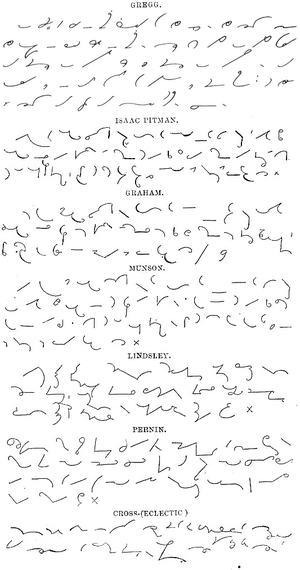Shorthand facts for kids

Shorthand is a special way of writing that uses symbols and abbreviations to write much faster than normal handwriting. It's like a secret code for speed! The word "shorthand" comes from Greek words meaning "narrow writing" (stenography), "short writing" (brachygraphy), or "swift writing" (tachygraphy).
Many types of shorthand exist. A good shorthand system has special symbols or short forms for common words and phrases. This lets someone who knows the system write as quickly as people speak. Journalists often use shorthand to quickly take notes during interviews or press conferences. Even today, some computer programs have a "shorthand" feature that helps you type common phrases faster.
In the past, before recording devices were common, shorthand was used a lot more. It was a key skill for secretaries, police officers, and journalists. While it was mostly used to write down what people said, some systems were also used for writing things in a compact way. For example, doctors might use shorthand notes in patient charts. Shorthand notes were usually temporary, meant to be typed up later. But sometimes, they were used for longer-term things, like writing diaries in code, such as the famous diary of Samuel Pepys.
Contents
Types of Shorthand Systems
How Shorthand Symbols Look
Shorthand systems can be grouped by how their symbols are shaped.
Geometric Shorthand
Geometric shorthands use simple shapes like circles, parts of circles, and straight lines. These lines are placed perfectly horizontal, vertical, or diagonal. The first modern shorthand systems were geometric. Famous examples include Pitman shorthand and Boyd's syllabic shorthand.
Script-like Shorthand
Script shorthands are designed to look more like regular handwriting. The first practical system of this type was the German Gabelsberger shorthand in 1834. This style is now common in many German, Austrian, and Scandinavian shorthand systems.
Semi-script Shorthand
Semi-script shorthands mix ideas from both geometric and script systems. They often use shapes based on ellipses (oval shapes). The most successful system of this type is Gregg shorthand, created by John Robert Gregg in 1888. Other examples include Teeline Shorthand.
Shorthand Like Regular Writing
Some shorthand systems try to make learning easier by using characters from the regular Latin alphabet. These are called alphabetic systems. While they might not be as fast as symbol-based systems (which can reach over 200 words per minute), they are much quicker to learn. You can often reach a useful speed of 70 to 100 words per minute in a fraction of the time.
Alphabetic systems sometimes add punctuation marks or use capital letters in special ways. Examples include Speedwriting. Some pure alphabetic systems, like Keyscript Shorthand, use only alphabet characters. This means you can even type them on a computer or cellphone.
How Vowels Are Shown
Shorthand systems also differ in how they show vowels (A, E, I, O, U).
- Alphabetic: Vowels are written with signs similar to consonants (e.g., Gregg).
- No Vowels: Some systems don't write individual vowels at all, except maybe for the first or last vowel in a word (e.g., Taylor).
- Marked Vowels: Vowels are shown using small marks like dots or ticks placed around the consonant signs.
- Position-based Vowels: The starting vowel of a word can be shown by how high or low the word is written on the line (e.g., Pitman).
Machine Shorthand Systems
Traditional shorthand is written by hand with a pen or pencil. But there are also machines for shorthand.
Machine shorthand is usually done on a stenotype, which is a special keyboard. These machines are often used in courtrooms to create quick transcripts or for live subtitling (like captions on TV). Other shorthand machines include the Velotype and Palantype.
Popular English Shorthand Systems Today
Pitman shorthand is still one of the most widely used forms, especially in the UK. It has been changed to work for 15 different languages. In the U.S., Gregg shorthand became more popular than Pitman's system.
In the UK, Teeline Shorthand is now taught more often than Pitman. Teeline is based on spelling, not just sounds. The National Council for the Training of Journalists recommends Teeline, and journalists need to reach 100 words per minute for certification. Teeline is also the most common shorthand taught to journalists in New Zealand.
In Nigeria, shorthand is still taught in colleges, especially for students studying office management and business.
Famous Shorthand Systems
- Current Shorthand (by Henry Sweet)
- Duployan shorthand (by Émile Duployé)
- Eclectic shorthand (by J.G. Cross)
- Gabelsberger shorthand (by Franz Xaver Gabelsberger)
- Deutsche Einheitskurzschrift (German Unified Shorthand)
- Gregg shorthand (by John Robert Gregg)
- Pitman shorthand (by Isaac Pitman)
- Speedwriting (by Emma Dearborn)
- Teeline Shorthand (by James Hill)
- Tironian notes (by Marcus Tullius Tiro), from 63 BC!
Images for kids
-
Dutch shorthand using the "System Groote"
-
The tombstone of Heinrich Roller, who invented a German shorthand system, with an example of his shorthand
-
Yiddish shorthand
-
Hebrew shorthand
See also
 In Spanish: Taquigrafía para niños
In Spanish: Taquigrafía para niños






